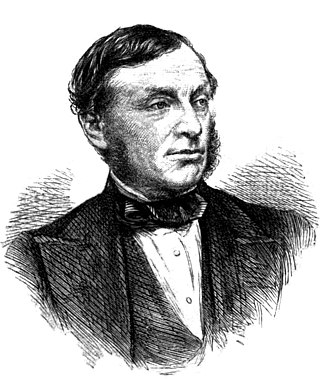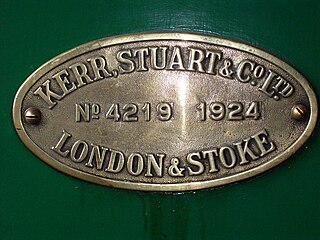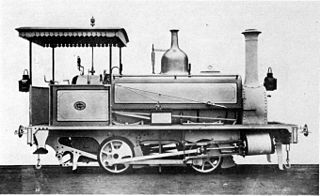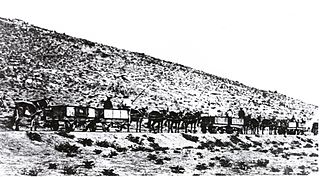
A steam locomotive is a locomotive that provides the force to move itself and other vehicles by means of the expansion of steam. It is fuelled by burning combustible material to heat water in the locomotive's boiler to the point where it becomes gaseous and its volume increases 1,700 times. Functionally, it is a steam engine on wheels.

A Fairlie locomotive is a type of articulated steam locomotive that has the driving wheels on bogies. The locomotive may be double-ended or single ended. Fairlies are most famously associated with the Ffestiniog Railway in North Wales.
Brush Traction was a manufacturer and maintainer of railway locomotives in Loughborough, England whose operations have now been merged into the Wabtec company's Doncaster UK operations.

The Hunslet Engine Company is a locomotive building company, founded in 1864 in Hunslet, England. It manufactured steam locomotives for over 100 years and currently manufactures diesel shunting locomotives. The company owns a substantial fleet of Industrial and depot shunting locomotives which are available for hire. The company is part of Ed Murray & Sons Ltd.

Sir Daniel Gooch, 1st Baronet was an English railway locomotive and transatlantic cable engineer. He was the first Superintendent of Locomotive Engines on the Great Western Railway from 1837 to 1864 and its chairman from 1865 until his death in 1889.
The Great Western Railway Hawthorn Class were 2-4-0 broad gauge steam locomotives for passenger train work. This class was introduced into service in 1865, a development of the Victoria Class.

The London, Midland and Scottish Railway (LMS) Fowler 3F0-6-0T is a class of steam locomotives, often known as Jinty. They represent the ultimate development of the Midland Railway's six-coupled tank engines. They could reach speeds of up to 60 mph (97 km/h).

Kerr, Stuart and Company Ltd was a locomotive manufacturer in Stoke-on-Trent, England.
R and W Hawthorn Ltd was a locomotive manufacturer in Newcastle upon Tyne, England, from 1817 until 1885.

Jones, Turner and Evans was a locomotive manufacturer in Newton-le-Willows, England from 1837, known as Jones and Potts between 1844 and 1852.
B. Hick and Sons, subsequently Hick, Hargreaves & Co, was a British engineering company based at the Soho Ironworks in Bolton, England. Benjamin Hick, a partner in Rothwell, Hick and Rothwell, later Rothwell, Hick & Co., set up the company in partnership with two of his sons, John (1815–1894) and Benjamin Jr (1818–1845) in 1833.

Douglas is a narrow gauge steam locomotive. It was built by Andrew Barclay Sons & Co. Ltd. in 1918. It was originally used by the Air Service Constructional Corps (RAF) then was bought in 1949 by Abelson & Co. (Engineers) Ltd. who then sold it to the Talyllyn Railway in 1953.

The South African Railways Class A 4-8-2T of 1888 is a steam locomotive class from the pre-Union era in the Colony of Natal.

W & J Galloway and Sons was a British manufacturer of steam engines and boilers based in Manchester, England. The firm was established in 1835 as a partnership of two brothers, William and John Galloway. The partnership expanded to encompass their sons and in 1889 it was restructured as a limited liability company. It ceased trading in 1932.

The Natal Railway 0-4-0WTNatal of 1860 was a South African steam locomotive from the pre-Union era in the Natal Colony.

James & Fred Howard of Britannia Ironworks, Bedford, later known simply as Howards, were one of the largest English makers of agricultural equipment, steam traction engines, and light railway equipment. At The Great Exhibition of 1851 they exhibited a range of horse-drawn implements. After World War I, Howards became part of AGE, Agricultural & General Engineers, along with many of the other British makers of similar machinery.

The Natal Government Railways Class K 2-6-0T of 1877 was a South African steam locomotive from the pre-Union era in the Natal Colony.

The Cape Government Railways 1st Class 0-4-0ST of 1876 was a South African steam locomotive from the pre-Union era in the Cape of Good Hope.

The Namaqualand 0-6-0T of 1871 were two South African steam locomotives from the pre-Union era in the Cape of Good Hope.

Midland Great Western Railway (MGWR) Classes 1, 2, 3, 4, 5 and 13 were 2-2-2 locomotives acquired over the period 1847-1862 serving the railway in its formative years.
















